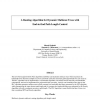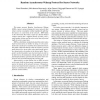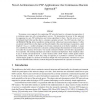COMCOM
2000
14 years 8 months ago
2000
The new Path Length Control (PLC) algorithm establishes and maintains multicast trees which maximize the bandwidth to be shared by multiple receivers and which satisfy the maximum...
ALGORITHMICA
2006
14 years 8 months ago
2006
We show that the number of t-ary trees with path length equal to p is t h(t-1) tp log2 p(1+o(1)) , where h(x)=-x log2 x-(1-x) log2(1-x) is the binary entropy function. Besides its...
BROADNETS
2004
IEEE
15 years 5 days ago
2004
IEEE
This paper presents Random Asynchronous Wakeup (RAW), a power saving technique for sensor networks that reduces energy consumption without significantly affecting the latency or c...
100
click to vote
BROADNETS
2004
IEEE
15 years 5 days ago
2004
IEEE
Survivability becomes increasingly critical in managing high-speed networks as data traffic continues to grow in both size and importance. In addition, the impact of failures is e...
FODO
1989
Springer
15 years 14 days ago
1989
Springer
We further refine the bounds on the path length of binary trees of a given size by considering not only the size of a binary tree, but also its height and fringe thickness (the d...
ISAAC
1997
Springer
15 years 17 days ago
1997
Springer
We give algorithms to find the optimal disjoint paths around a rectangle. The set of disjoint paths connects a set of sources to a set of sinks (no fixed pairing between the sour...
SPAA
2003
ACM
15 years 1 months ago
2003
ACM
We propose a new approach for constructing P2P networks based on a dynamic decomposition of a continuous space into cells corresponding to servers. We demonstrate the power of thi...
ISMVL
2003
IEEE
15 years 1 months ago
2003
IEEE
We consider the path length in decision diagrams for multiple-valued functions. This is an important measure of a decision diagram, since this models the time needed to evaluate t...
ASPDAC
2004
ACM
15 years 1 months ago
2004
ACM
— In many verification tools methods for functional simulation based on reduced ordered Binary Decision Diagrams (BDDs) are used. The evaluation time for a BDD can be crucial an...
GCC
2005
Springer
15 years 1 months ago
2005
Springer
Building a topology-aware peer-to-peer overlay network can bring many advantages, such as providing locality-aware connectivity and reducing routing path length. While its benefit...




